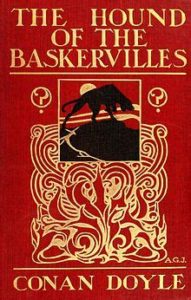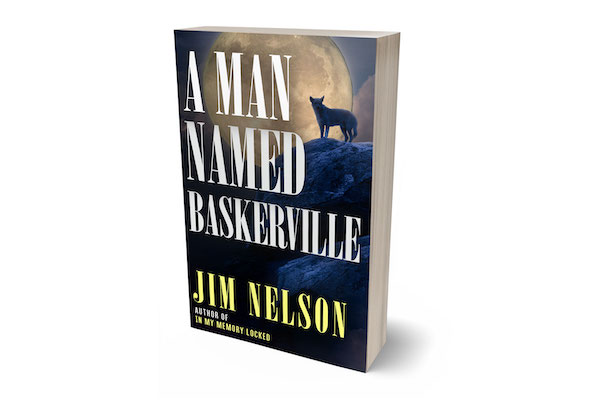See the “Twenty Writers, Twenty Books” home page
for more information on this series.
[Note: The following is adapted and compressed from the afterword to A Man Named Baskerville. It reveals some details from the book. It also contains spoilers to the book it was inspired by, Arthur Conan Doyle’s The Hound of the Baskervilles.]
Years ago, while traveling Japan via its Shinkansen bullet train, I found myself without a book to read. An ebook reader I’d installed on my phone came with a free sample to whet the reader’s appetite. That book was Arthur Conan Doyle’s The Adventures of Sherlock Holmes, a collection of the earliest Holmes short stories. (I explore this incident in greater detail in my 2016 post “Sherlock by Train.”)
The collection stands as a record of a remarkably creative streak. So remarkable, if Doyle were to have stopped writing after its publication, we would still be talking about his literary creation and storytelling prowess. The titles of the stories within are as familiar as the books of the Bible: “A Scandal in Bohemia,” “The Red-Headed League,” “The Man with the Twisted Lip,” “The Adventure of the Speckled Band.” Perhaps the only missing short story title of comparable infamy is “The Adventure of Silver Blaze,” published in The Memoirs of Sherlock Holmes a mere two years later. In toto, they represent the height of Doyle’s powers and inventiveness.
None of this inspired me to write A Man Named Baskerville. As exciting and inventive as a great Sherlock Holmes story can be, never have I entertained the question that has dogged countless other producers of Doyle homages and pastiches: Could I write my own Sherlock Holmes story? Honestly, the thought has never crossed my mind.

After consuming the first collection in a rush of reading, I used the opportunity of a brief train stop and some free wireless Internet access to download more Sherlock Holmes books for our continued journey. I had read a little of Doyle’s work before, and never found much interest in it. They were too Victorian for my tastes, too concerned with Empire and upright decency and British morality. My California upbringing, and the plain-speaking tastes I inherited from my parents, led me to the hardboiled school of Chandler, Hammett, and Cain. Nathanael West’s grotesqueries and William Gibson’s cyberpunks are a better fit for me than Holmes’ Irregulars.
On that train ride, my interest in Sherlock Holmes kindled. Holmes may not have walked Chandler’s mean streets, but he did present a more compelling moral force than I’d sensed before. As with the hardboiled school, Holmes time and again must balance his own sense of justice against the British legal system’s notion of the same. Doyle wrote for an audience who would understand those boundaries implicitly. A hundred and ten years later, I viewed Holmes’ sense of justice through a different lens. This came to a point when my reading reached The Hound of the Baskervilles.
The book was first serialized in 1901, ten years after that auspicious run of early short stories. Doyle had killed off Holmes in “The Final Problem” (1893) hoping to rid himself of the literary creation upstaging all his other work. An appalled public demanded more stories featuring Holmes, and publishers increasingly pressured Doyle to satisfy the market’s cravings.
Inspired by a trip to Devon and its local folklore of wisht hellhounds roaming the countryside at night, Doyle produced The Hound of the Baskervilles. To avoid what we today call “continuity problems,” he retroactively dated its events to October 1888, three years before the publication of his earliest stories. This places the story square in the middle of the Autumn of Terror, when a serial killer dubbed Saucy Jack terrified London, while, across the Atlantic, the Empire of Brazil was warily beginning its dissolution.
One overlooked quality of Doyle’s writing is that his knack for concise storytelling in the short form executes equally brilliantly in the longer form. I’ve seen adept short story writers get fouled up when they attempt to tackle the novel. The pacing and breathing cadences that permit a runner to win the 100-meter dash do not sustain when attempting a marathon. Yet Doyle’s economical style holds up with Hound, making for dazzling quick cuts between crucial scenes, and exposition that does not lead the reader to impatiently flip ahead. Doyle had a gift for paring down prose to its vital emotional and informational elements without stripping it of that uniquely English sense of mood and atmosphere. One also sees in Hound Doyle’s assiduous control of pacing. The early chapters draw out their eerie scenes, while the closing chapters barrel headlong toward the conclusion. The movement becomes so breathless at the end, it takes pure inference on the part of the reader to detect scene changes.
Readers either love or hate this no-nonsense approach to storytelling. Either way, the final output of his opus on the moors is consistent with this quality, and obviously has held the public’s interest for well over a century.
None of this inspired me to write this book, either. I grew to admire Doyle’s writing while traveling by bullet train, but I never craved to imitate it. The first fourteen chapters of The Hound of the Baskervilles served to reaffirm my growing estimation of the man’s talents, but not to pick up a pen.

What did inspire me to write A Man Named Baskerville? The fifteenth and final chapter of the book it derives from.
All detective mysteries deal in sleight-of-hand. Keeping the perpetrator out of the narrative limelight until the moment the solution is announced is a tried-and-true technique for maintaining the element of surprise. In response, savvy readers have learned to guess whodunnit by evaluating how much “screen time” the author gives the suspects. The most obvious suspect is never culpable. The suspect we’ve read the least about is quite often guilty up to their eyeballs.

And that’s pretty much the case in The Hound of the Baskervilles. The perpetrator is one we hear precious little about, an absentminded collector of butterflies and moths named Jack Stapleton who lives with his sister (the nineteenth-century equivalent to rooming in your parents’ basement, apparently). He’s not the least elaborated-upon character in the book, but he is pictured as far removed from the crimes and the curse of the Baskervilles. When Holmes and Watson finally suspect his guilt, Doyle spends no time speculating on his motivations in favor of keeping the story moving at a brisk clip.
Doyle knew the reader would eventually demand to know why Stapleton posed under an assumed identity to murder his uncle in such a contrived way, and then attempt the same on his cousin. To sew things up, in Chapter 15, Watson calls on Holmes to explain the background of Jack Stapleton. Holmes launches into fourteen pages of exposition, a matter-of-fact recounting of Rodger’s life from the New World to Devonshire, England.
Much detail is omitted, of course, but Holmes’ reckoning of Rodger’s life is a far more plumbed-out biography than I think any reader expected. After all, Holmes could have simply stated, “He was raised abroad and returned to England to kill his uncle and claim his estate.” Yes, that could be worded more artfully, but Doyle stretched himself to fill in the blanks.
I don’t know why Doyle felt the need to so thoroughly detail Rodger Baskerville’s life. I’m not sure anyone does. In my research for A Man Named Baskerville, I never located a definitive answer to the question. Perhaps in Doyle’s papers, or in a complete treatise on his life and work, an answer may be found. Perhaps it was a modernist faith in the triumph of reason—all things must be explained that can be explained—that led Doyle to stretch himself, much as he uses many pages to lay out the backstory in A Study in Scarlet and some of his short stories.
What I do know is, reading those seemingly superfluous fourteen pages of Rodger’s life struck me as a kind of boggy sinkhole in the tale. It felt Arthur Conan Doyle had wanted to write two books, Rodger’s life story and The Hound of the Baskervilles. Unable or uninterested in writing the first, he wrote the latter and included a précis of the former in the final chapter.
Fascinated, I made copious notes of Holmes’ reckoning of Rodger’s life. Later, I transferred and organized them on my computer. A bell tinkled in my mind, a Pavlovian reaction all writers develop: Is there a novel here? I let the idea stew. Holmes’ reckoning might appear a rich vein to mine, but once I started digging, it might yield little more than a couple of small gems.
And how would readers react to Rodger as a main character? Yes, everyone says they like stories about villains—but too often those so-called villains are more like lovable rogues or bad boys with a soft spot. Was I trying to humanize Rodger Baskerville? That’s exactly what a novel does: It humanizes. Would it be a Victorian “Sympathy for the Devil”?
Maybe, I thought, I should just write the damn thing and see what comes out of the keyboard.
I made a private agreement with myself: I would not write yet another pastiche of Sherlock Holmes, of which there are plenty to pass around. The book would be told in Rodger’s voice and not in imitation of Doyle’s Watson. Of course, that didn’t excuse me from the challenges of writing a historical novel, which include diction, grammar, tone of voice, colloquialisms, and historical accuracy. Nor could I write such a book without featuring Holmes and Watson at some point.
Mostly, though, my doubts centered on originality. Certainly someone had executed on this idea since the publication of Doyle’s book. Internet searches yielded nothing of the sort.
It became a secret too juicy to keep to myself: In the final chapter of The Hound of the Baskervilles, Arthur Conan Doyle embedded a working outline for a novel—a rousing novel, in my estimation—that had been overlooked for over a century. It took me five years to set aside my private doubts and write it.
Yes, it was exhilarating to liberally borrow from a master’s synopsis and expand it into this novel. No, having said synopsis to work from did not make my job any easier.

When I planned A Man Named Baskerville, I failed to see how a man with Rodger’s background would not bring to Dartmoor one or more Central or South American dialects along with his impeccable upper-class English accent. He would also bring with him a rich and varied New World culture as his starting point of reference.
Once in England, around his neck would be the weight of several albatrosses: His father’s suspicious exile; his “ethnic” upbringing and foreign tongue; his lack of secure income; his marriage to a dusky woman most un-Anglo-Saxon. Only his upper-crust accent would save him. It would work in the British Isles like a charge card with no spending limit. After all, he didn’t merely fool the English into thinking he was one of them; he fooled them into thinking he was better than most of them.
Freud’s narcissism of small differences is an underappreciated observation of the continuing human condition. As long as people lift themselves up by cataloging their differences with outsiders, there will always be Rodger Baskervilles walking among us.
That’s why I wrote A Man Named Baskerville.
